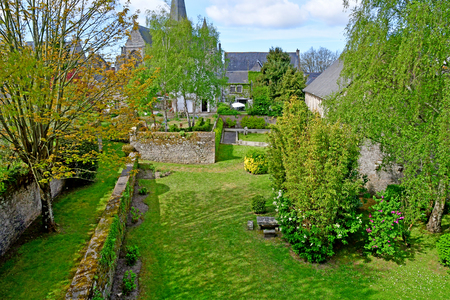Introduction to Wildlife Challenges in Allotments
If you’ve ever wandered through the patchwork of British allotments on a dewy morning, you’ll know the delight of seeing rows of carrots, beds of lettuces, and proud sunflowers stretching towards the sky. But alongside these green triumphs comes a persistent challenge: wildlife, especially rabbits and deer, who see our lovingly tended plots as an irresistible feast. For many community gardeners, these creatures are both a source of wonder and frustration, as they can quickly undo months of hard work. In Britain, where community gardening is deeply rooted in tradition and neighbourly bonds, the struggle with nibbling rabbits and browsing deer is more than just a personal inconvenience—it’s a shared experience that impacts crop yields, plot morale, and even friendships across the allotment site. Understanding how to protect our gardens from these persistent visitors has become an essential part of allotment life, blending traditional wisdom with modern ingenuity.
Traditional Fencing Methods: Tried-and-True Approaches
When it comes to British allotments, time-honoured fencing methods have stood as the first line of defence against curious rabbits and nimble deer for generations. These classic solutions not only reflect the UK’s gardening heritage but also foster a sense of shared tradition between parent and child as they work together to protect their beloved plots.
Wattle Fencing: An Age-Old Craft
Wattle fencing, woven from supple hazel or willow branches, has adorned British landscapes since medieval times. Its rustic charm is matched by its practical benefits—closely spaced rods create a living barrier that discourages smaller animals from slipping through while blending beautifully with native greenery. Though labour-intensive, constructing wattle fencing can become a rewarding family project, connecting children with nature and craftsmanship.
Rabbit Wire: The Practical Protector
For many allotment holders, rabbit wire—also known as galvanised mesh—remains a staple. Typically buried at least 30cm underground and standing 60cm or higher above ground, this metal mesh forms an almost impenetrable wall for persistent rabbits. Let’s compare some key features of traditional fencing options:
| Fencing Type | Main Material | Protection Level | Maintenance | Heritage Value |
|---|---|---|---|---|
| Wattle | Hazel/Willow | Moderate (rabbits) | Medium (replace branches periodically) | High (ancient British craft) |
| Rabbit Wire | Galvanised Mesh | High (rabbits/deer with height adjustment) | Low (occasional rust checks) | Medium (Victorian era onwards) |
| Wooden Paling | Treated Timber | Good (rabbits/deer if tall enough) | Medium (repainting, repairs) | High (classic British allotments) |
Wooden Paling: The Allotment Classic
A walk through any English allotment will reveal stretches of wooden paling fencing—upright timber slats fixed to horizontal rails. When built high enough, these barriers dissuade both rabbits and deer while offering a picturesque backdrop for climbing beans or sweet peas. They echo the patchwork charm of traditional community gardens and invite children to observe how solid boundaries nurture thriving plant life inside.
The Enduring Appeal of Tradition
The beauty of these tried-and-true approaches lies not just in their effectiveness, but in the stories they tell and the hands-on lessons they provide. Parents and children working side by side learn about wildlife habits, local history, and the joy of building something lasting together. In this way, each fence becomes more than a barrier—it’s a living link between past generations and future harvests.

3. Modern Fencing Innovations for Increased Protection
As British allotments adapt to the shifting landscape between city and countryside, modern fencing solutions have blossomed like new shoots after spring rain. Allotment holders now have access to a bouquet of contemporary options, each designed to outwit persistent rabbits and nimble deer while respecting both the environment and local traditions.
High-Tensile Mesh: Strength Meets Subtlety
One of the most popular choices is high-tensile mesh fencing. Unlike traditional wire netting, this modern mesh features closely spaced, robust wires that resist gnawing and forceful impacts. Its subtle appearance blends into the greenery of the plot, much like ivy weaving through a garden wall, providing protection without disturbing the allotment’s natural charm. These fences can be installed higher than standard versions—often up to 1.8 metres—to prevent deer from leaping over, while the bottom edge is buried or turned outward to deter burrowing rabbits.
Electric Fencing: A Gentle Deterrent
Electric fencing has grown increasingly popular on larger or more vulnerable plots. These systems deliver a mild shock upon contact, gently reminding curious wildlife to keep their distance—much like a respectful boundary drawn with a neighbour’s child. British allotmenteers often choose solar-powered units for sustainability, ensuring their protective measures are as gentle on the planet as they are effective against unwelcome visitors.
Sustainable Barriers: Harmony with Nature
For families wishing to embrace an eco-friendly ethos, sustainable barriers such as woven hazel panels or living willow fences have taken root in many communities. These natural fences echo ancient hedgerows, offering shelter for pollinators and birds while forming a living shield against four-legged intruders. Not only do these barriers foster biodiversity, but they also provide an enchanting way for parents and children to connect with nature—planting, weaving, and watching their defences grow together season by season.
Adapting to Urban-Rural Changes
The mosaic of British allotments is ever-changing; urban sprawl meets rolling countryside in unexpected ways. Modern fencing innovations allow plot holders to tailor their defences according to space, threat level, and environmental values—whether it’s combining high-tech solutions with traditional plantings or choosing materials that reflect a commitment to sustainability. In this way, families can nurture both their harvests and a sense of stewardship for the land, standing tall against challenges just as sturdy as their allotment fences.
4. Choosing the Right Materials: Durability, Cost, and Ecology
When it comes to protecting your cherished British allotment from rabbits and deer, the materials you choose for your fencing will make all the difference. With so many options available, it’s important to strike a balance between longevity, affordability, and environmental friendliness—all while considering how well each material stands up to the often unpredictable UK weather.
Comparing Traditional and Modern Fencing Materials
| Material | Durability | Cost | Ecological Impact | Suitability for UK Climate |
|---|---|---|---|---|
| Wood (Treated) | Medium-High | Moderate | Variable (depends on treatment) | Good with regular maintenance |
| Galvanised Wire Mesh | High | Moderate-High | Recyclable, low impact | Excellent; resists rust and damp |
| Plastic Netting | Low-Medium | Low | Poor (non-biodegradable) | Suffers in strong winds & sun exposure |
| Bamboo/Reed Panels | Low-Medium | Low-Moderate | Sustainable if sourced responsibly | Mildews in damp conditions; best as temporary solution |
| Livi ng Willow Hedges | High (once established) | Initial investment, then low cost | Excellent; boosts biodiversity | Loves wet British soil; needs time to grow dense enough for protection |
| Palisade Steel Fencing (Modern Option) | Very High | High upfront, low maintenance cost over time | Long-lasting, recyclable at end of life | No rot or rust issues; suitable for exposed sites but visually less natural for family plots |
A Family-Friendly Approach to Material Choice
If you’re tending your plot with little ones in tow, consider not only what keeps wildlife out but also what welcomes tiny hands in. Smooth-finished timber or willow hedges are gentle on curious fingers, while modern wire mesh can be installed with child-safe capping strips along the top. Involving children in planting a living hedge can turn a simple boundary into a magical garden project—watching as slender twigs transform into a leafy haven that shelters both plants and helpful insects.
The Eco-Conscious Allotmenteer’s Guide:
- Sustainable Sourcing: Choose FSC-certified timber or recycled metal where possible.
- Biodiversity Boost: Living fences like willow offer shelter to pollinators and birds.
- Repair Over Replace: Traditional wooden fences can often be patched up rather than replaced entirely.
A Note on Cost vs. Longevity:
An affordable fence may seem appealing initially, but frequent replacements due to rot or storm damage can end up costing more in the long run. Investing in robust materials like galvanised mesh or nurturing a living hedge pays off over time—both for your wallet and for the flourishing ecosystem of your British allotment.
5. Practical Installation Tips from Allotment Communities
When it comes to keeping rabbits and deer at bay, there’s nothing quite like the collective wisdom of British allotment holders. Many seasoned gardeners across the UK have found that success lies not just in choosing the right fencing materials, but also in clever installation techniques and good neighbourly collaboration.
Community Wisdom on Getting Fencing Right
Allotmenteers often recommend digging your fence at least 15cm (about 6 inches) into the ground to prevent rabbits from burrowing underneath—a tip passed down through generations. Some plot holders in Kent suggest bending the bottom of the wire mesh outward like a little apron before burying it, which acts as an extra deterrent for persistent diggers. For deer, height matters: local advice from Yorkshire points towards fences at least 1.8 metres tall (that’s about 6 feet), with sturdy posts spaced no more than two metres apart to withstand a curious stag’s push.
Teamwork Makes for Sturdier Solutions
Many British allotment sites operate cooperatively, with neighbours pooling resources to create communal barriers around whole plots rather than just individual beds. In Brighton, for example, several gardeners shared how they coordinated group workdays—armed with spades and cups of tea—to erect rabbit-proof fencing together. This not only strengthens defences but also builds a sense of community spirit and shared responsibility.
Little Touches That Make a Big Difference
Experienced hands suggest adding a second line of protection by placing chicken wire along gates or weak spots. Others find that hanging tin cans or using aromatic herbs like lavender near fences can confuse or deter animals—tricks inspired by both tradition and playful experimentation. And don’t forget regular checks: one allotment family in Cornwall makes it a Sunday ritual to walk their fence lines together, making repairs while sharing stories and passing on knowledge to younger members.
With every post hammered and mesh stretched tight, British gardeners show that fencing is more than just a barrier—it’s a living part of allotment life, shaped by shared effort and local ingenuity.
6. Blending Fencing with Nature: Aesthetic and Wildlife-Friendly Options
Fencing in British allotments needn’t mean choosing between protecting your precious crops and supporting local wildlife. In fact, the most rewarding allotment spaces are those where families can marvel at both thriving veg patches and the gentle buzz of bees or fluttering butterflies. Let’s explore how modern and traditional fencing solutions can be blended seamlessly with nature, creating boundaries that safeguard against rabbits and deer while nurturing the UK’s native flora and fauna.
Harmonious Fencing Materials
Timber, willow hurdles, and hazel panels are traditional choices that not only echo the British countryside but also provide shelter for insects and small birds. Unlike harsh metal or plastic options, these materials soften the landscape and weather beautifully over time. When sourcing wood, opt for FSC-certified products to ensure your fence is as sustainable as it is effective.
Wildlife Passages for Small Creatures
While keeping out larger nibblers like rabbits and deer is crucial, consider leaving small gaps or installing ‘hedgehog highways’ at ground level. This allows hedgehogs and other beneficial creatures to roam freely between plots without compromising your defences. These thoughtful touches support biodiversity—a value celebrated in many UK allotment communities.
Planting Alongside Fences
Encourage pollinators by planting native wildflowers along fence lines or weaving climbers such as honeysuckle or sweet peas through mesh or trellis sections. Not only do these blooms bring colour and scent to your plot, but they also offer food and shelter for bees, butterflies, and ladybirds. Choose plants that thrive locally for best results.
Aesthetic Integration
Fencing doesn’t have to dominate the view. Painting wooden fences in soft green hues or allowing them to silver naturally helps them blend into the allotment landscape. You might even involve children in decorating panels with painted wildlife motifs—a fun way to spark conversations about nature and stewardship.
Community Inspiration
Many British allotments take pride in their balance of productivity and environmental care. Share ideas with neighbours about wildlife-friendly fencing or join community projects aimed at enhancing habitats around boundary lines. Together, you can create an environment where people, plants, and animals all flourish.
By approaching fencing as both a protective measure and an opportunity to support local wildlife, allotmenteers across the UK can enjoy harmonious spaces that inspire young and old alike—reminding us all that caring for our crops goes hand-in-hand with caring for the world around us.


